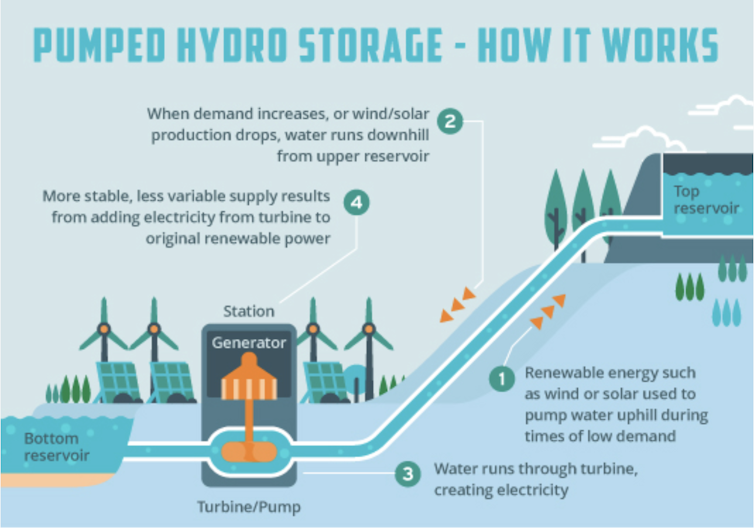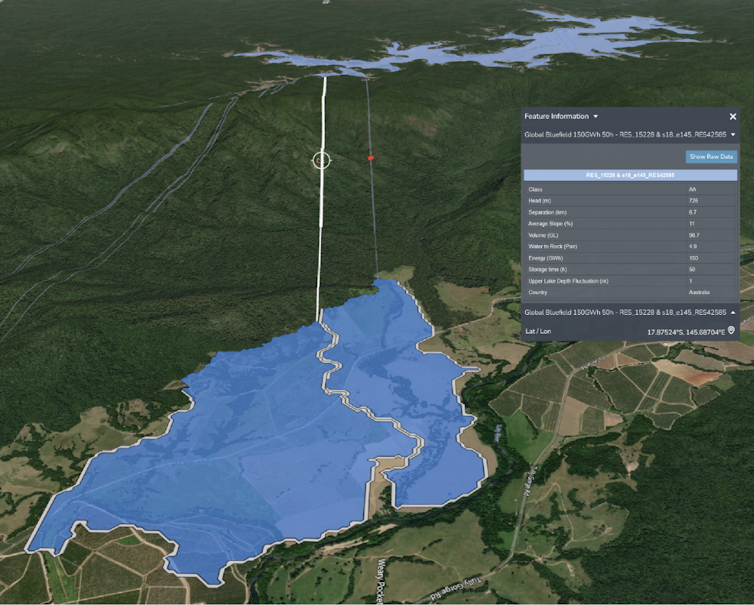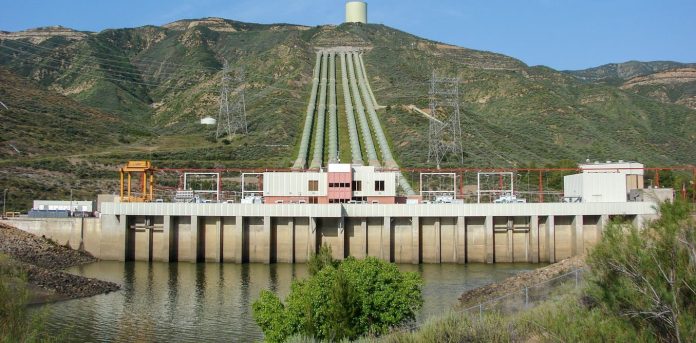Queensland election signals both major parties accept pumped hydro and the renewable energy transition as inevitable
Solar and wind have won the global energy race. They accounted for 80% of new global power capacity installed in 2023. In Australia, 99% of new capacity is wind or solar.
The Queensland election campaign suggests both sides of politics have embraced the renewable energy transition. But solar and wind are variable and need energy storage. That is where pumped hydro energy storage and batteries come in.
Both are off-the-shelf technologies. And both are already being used on a vast scale.
Having promised 80% renewable energy by 2035, the incumbent Labor government is committed to large pumped hydro systems at Borumba, on the Sunshine Coast, and Pioneer-Burdekin, near Mackay. The A$14.2 billion Borumba project appears to have support from both major parties. However, the Liberal National Party (LNP) says it will scrap the $12 billion Pioneer Burdekin project and the renewables target if elected.
While Pioneer-Burdekin is a very good site, there are good alternatives. The LNP says it “will investigate opportunities for smaller, more manageable pumped hydro projects”. Regardless, in supporting more pumped hydro storage and rejecting the federal Coalition’s nuclear power plans, the state LNP is accepting the renewable energy transformation as inevitable.
What is pumped hydro energy storage?
Pumped hydro systems store surplus electricity from solar and wind on sunny and windy days. The electricity is used to pump water from a lower reservoir to an upper reservoir. This water can later be released downhill though turbines to generate power when it’s needed.

This proven technology has been used for over a century. It accounts for about 90% of global energy storage. Australia has three pumped hydro systems (Tumut 3, Kangaroo Valley, Wivenhoe) and two under construction (Snowy 2.0 and Kidston).
Snowy 2.0 will last for at least 100 years. Its capacity (350 gigawatt-hours, GWh) is equivalent to 6 million electric vehicle batteries. It’s enough to power 3 million homes for a week.
Due to start operating in 2028, Snowy 2.0 will cost about $12 billion. That’s roughly equivalent to $2,000 for a 100-year-lifetime EV battery. Pumped hydro energy storage is cheap!
ANU’s RE100 Group has published global atlases of about 800,000 potential pumped hydro sites. None require new dams on rivers. Some are new sites (greenfield). Others would use existing reservoirs (bluefield) or old mines (brownfield).
Let’s work with the gravity. Australian National University study has identified more than 600 000 sites and 23 000 TWh worth of locations for pumped hydro electricity storage.
1% of that would be enough for three days of global electricity demand. 1/11https://t.co/TJa5QSplzg pic.twitter.com/2kcZfweUWi— Visa Siekkinen (@visaskn) February 28, 2023
What about batteries?
Batteries are best for short-term storage (a few hours). Pumped hydro is better for overnight or several days – Snowy 2.0 will provide 150 hours of storage.
A combination of these storage systems is better than either alone.
As with any major infrastructure, pumped hydro development has costs and risks. It has high upfront capital costs but very low operating costs.
What are Queensland’s options?
In Queensland, solar and wind electricity rose from 2% to 26% of total generation over the past decade. It’s heading for about 75% in 2030 as part of Australia’s 82% renewables target.
Queensland needs roughly 150 GWh of extra storage for full decarbonisation. After accounting for Borumba (50 GWh), batteries and other storage, Pioneer-Burdekin (120 GWh) would meet that need.
A similarly sized system or several smaller systems would also suffice. The latter approach has advantages of decentralisation but would cost more and have environmental impacts in more places.
The state has thousands of potential sites that are “off-river” (do not require new dams on rivers). The table below shows 15 premium sites, most with capacities of 50–150 GWh. Some larger sizes are included for interest – 5,000 GWh would store enough energy for 100 million people.
The key technical parameters are:
- head: the altitude difference between the two reservoirs – bigger is better
- slope: the ratio of the head to the distance between the reservoirs – larger slope means shorter tunnel
- W/R: the volume of stored water (W) divided by the volume of rock (R) needed for the reservoir walls. Large W/R means low-cost reservoirs.
Clicking on each name takes you to a view of the site with more details.
| Site | Size (GWh) | Type | Head (m) | Slope (%) | W/R |
|---|---|---|---|---|---|
| Mackay | 50 | Green | 800 | 13 | 8 |
| Townsville | 50 | Green | 490 | 8 | 19 |
| Pentland | 50 | Green | 340 | 6 | 10 |
| Boyne | 50 | Green | 390 | 8 | 14 |
| Beechmont | 50 | Blue | 427 | 6 | 8 |
| Tully | 50 | Blue | 726 | 10 | 9 |
| Tully | 150 | Blue | 726 | 11 | 5 |
| Townsville | 150 | Green | 440 | 8 | 14 |
| Mackay | 150 | Green | 412 | 6 | 17 |
| Mackay | 150 | Green | 680 | 9 | 7 |
| Yeppoon | 150 | Green | 390 | 8 | 17 |
| Proserpine | 500 | Green | 600 | 12 | 7 |
| Townsville | 500 | Green | 490 | 18 | 6 |
| Ingham | 1,500 | Green | 650 | 6 | 8 |
| Ingham | 5,000 | Green | 650 | 7 | 3 |
Pumped storage in far north Queensland is valuable because it can absorb solar and wind energy from the Copperstring transmission extension to Mt Isa. It can then send it down the transmission line to Brisbane at off-peak times. This will ensure the line mostly operates close to full capacity.

What about the rest of Australia?
Pumped storage and batteries keep the lights on during solar and wind energy droughts that occasionally occur in winter in southern Australia. They also meet evening peak demand.
The fossil fuel lobby argues gas is needed in the energy transition. But pumped hydro and battery storage eliminate the need for gas generators and their greenhouse gas emissions.
In the past decade, solar and wind generation in Australia’s National Electricity Market increased from 6% to 35%. Gas fell from 12% to 5%.
Most pumped hydro projects can be built off rivers. The same water is repeatedly transferred between the reservoirs. This means the system keeps running during droughts and avoids the impacts of new dams blocking rivers and flooding valleys.
The environmental and social impacts of off-river pumped hydro projects are much lower than for conventional hydropower or fossil fuel projects.
The system uses very common materials, primarily water, rock, concrete and steel. Very little land is flooded for off-river pumped hydro to support a 100% renewable energy system: about 3 square metres per person. Only about 3 litres of water per person per day is needed for the initial fill and to replace evaporation.
Sometimes, safely disposing of tunnel spoil is a challenge – as with mining (including for coal and battery metals). Any major new generation facility and its transmission lines may involve clearing and disturbing bushland. Local communities sometimes oppose pumped hydro developments.
In Australia, ANU identified 5,500 potential sites. Only one to two dozen are needed to enable the nation to be fully powered by renewables.
About a dozen pumped hydro projects are in detailed planning. Hydro Tasmania’s Battery of the Nation is proposed for Cethana. Other prominent projects include Oven Mountain, Central West, Upper Hunter Hydro and Burragorang in New South Wales.
You can expect to see more pumped hydro systems in a state near you.![]()
Jamie Pittock, Professor, Fenner School of Environment & Society, Australian National University and Andrew Blakers, Professor of Engineering, Australian National University
This article is republished from The Conversation under a Creative Commons license. Read the original article.



